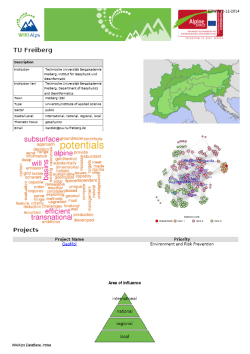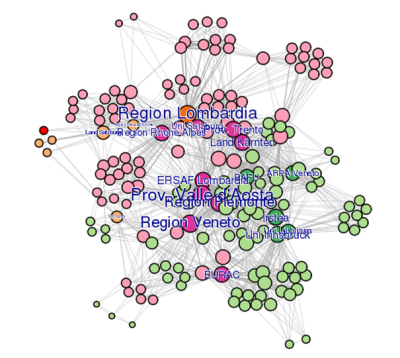Stakeholder factsheets
The stakeholder factsheet can be understood as a curriculum vitae (cv) of a stakeholder's project action in the AS. It contains the most important information on a stakeholder, his competences and his projects. The function included in the database creates the factsheet automatically from the data available in the database, and it is possible to download it (pdf file). The information provided for each stakeholder concerns
- general information such as town, type, sector, spatial level, thematic focus,
- an overview of the Alpine Space 2007-2013 project participations with links to WIKIAlps project sites,
- a Stakeholder Network Graph depicting position and relationships within the AS stakeholder network,
- a word cloud indicating the main interests of the stakeholder in the AS (based on project summaries),
- a diagram showing his main level(s) of influence on spatial devevelopment,
- and a stylised map of the programme area with the location of the stakeholder.

Stakeholder Network Graph
Data on project participation of the stakeholders has been used to draw social network graphs. The method comes from social network analysis (see Hanneman and Riddle (2005) for an introduction) which is based on mathematical tools and graph theory. By definition, a social network is simply a set of actors (nodes), that may have relationships (edges) with one another.
- What exactly does it show ?
Our stakeholder network graphs show the network of Alpine Space (AS) institutions for the thematic fields analysed by WIKIAlps. In particular, they show proximity, relationships and their strength between stakeholders. It is based on stakeholders' participation in 30 projects across two thematic fields. The data came from the Joint Technical Secreteriat of the AS Programme. We consider institutions as stakeholders and projects as social groups. Inside such a group all stakeholders have relationships to one another. A stakeholder participating in two or more groups creates links between these groups, in other words he acts as a hub between projects.

- How to read the graph ?
The graph consists of nodes (institutions) and edges (relations), which are arranged using a specific layout algorithm. To improve readibility and understanding of the network and individual positions of stakeholders, we had to make some choices regarding the layout of the graph. The graph conveys information on stakeholder centrality, direct and indirect relationships with other stakeholders and intensity of relationships.
- We highlight centrality degree in three different ways, i.e. by the size of the node, by the size of the name and thirdly using graduated colours for nodes (darker nodes indicate superior centrality).
- We indicate direct and indirect relationships between stakeholders using different colour codes. The legend shows 4 classes of nodes. First, red colour helps to localize the stakeholder of interest on the graph. Further on, we distinguish direct (rank 1) relationships, i.e. all partners with whom the stakeholder of interest worked directly a project . Last, indirect links (ranks 2 and 3) concern relationships through other projects that go beyond the rank 1 partners and thereby create links with new stakeholders. Stakeholders beyond rank 3 are not considered in the graph.
- Intensity of relationships are indicated via thickness of edges.
- Drawing 'on the fly'
Both stakeholder factsheets and graphs are automatically generated from the database. Thus, for the graphs, layouts may change from one stakeholder to another, but layouts for one stakeholder will always be the same. It is important to note that among all projects in the scope of the WIKIAlps project, almost all partners belong to the same network (linked at least via rank 3 relationships). Only two projects (Alps-Bio-Cluster, Plat.f.o.r.m, 13 stakeholders) are strictly independent.